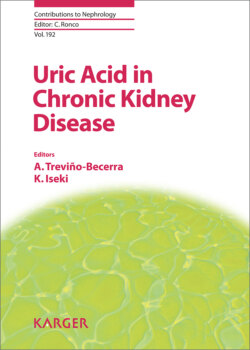Читать книгу Uric Acid in Chronic Kidney Disease - Группа авторов - Страница 33
На сайте Литреса книга снята с продажи.
Introduction
ОглавлениеThe first associations between hyperuricemia and cardiovascular and renal disease date to the 19th century. The first findings were described in gouty patients in whom “interstitial nephritis in almost the whole parenchyma that resulted in the destruction of glomeruli, tubules, and arterioles” was found [1]. It was thought that uric acid also attacked the arteries of other tissues and caused hypertension [1]. In the 20th century, the term gouty nephropathy was coined to describe the renal lesions observed in a vast proportion of patients with gout. Nevertheless, the notion of “gouty nephropathy” was abandoned, as the focal crystal deposition of uric acid seen in gout could not account for the diffuse nature of the kidney lesions characterized by microvascular disease, interstitial fibrosis, and glomerulosclerosis. Moreover, such lesions are also associated with aging and long-term hypertension. Thus, it was thought that the chronic renal damage observed in gouty patients was related to those factors. In the course of years, several epidemiological studies consistently found that hyperuricemia strongly associated with chronic renal tubulointerstitial disease and cardiovascular disease, and that it even had a predictive value for hypertension and coronary disease. Also, studies in patients with familial juvenile hyperuricemic nephropathy showed that decreased excretion of uric acid and hyperuricemia preceded the onset of renal disease and early treatment with allopurinol retarded renal damage [2–4]. As hyperuricemia mostly results from decreased fractional excretion of uric acid, it was suggested that if uric acid were toxic per se, the site of first involvement would be the kidney, and therefore it would be valuable to test this hypothesis with an experimental model.
